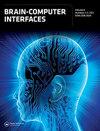Identifying the Attended Speaker Using Electrocorticographic (ECoG) Signals.
IF 2.1
Q3 ENGINEERING, BIOMEDICAL
引用次数: 26
Abstract
People affected by severe neuro-degenerative diseases (e.g., late-stage amyotrophic lateral sclerosis (ALS) or locked-in syndrome) eventually lose all muscular control. Thus, they cannot use traditional assistive communication devices that depend on muscle control, or brain-computer interfaces (BCIs) that depend on the ability to control gaze. While auditory and tactile BCIs can provide communication to such individuals, their use typically entails an artificial mapping between the stimulus and the communication intent. This makes these BCIs difficult to learn and use. In this study, we investigated the use of selective auditory attention to natural speech as an avenue for BCI communication. In this approach, the user communicates by directing his/her attention to one of two simultaneously presented speakers. We used electrocorticographic (ECoG) signals in the gamma band (70-170 Hz) to infer the identity of attended speaker, thereby removing the need to learn such an artificial mapping. Our results from twelve human subjects show that a single cortical location over superior temporal gyrus or pre-motor cortex is typically sufficient to identify the attended speaker within 10 s and with 77% accuracy (50% accuracy due to chance). These results lay the groundwork for future studies that may determine the real-time performance of BCIs based on selective auditory attention to speech.使用皮质电图(ECoG)信号识别出席的演讲者。
患有严重神经退行性疾病(如晚期肌萎缩侧索硬化症(ALS)或闭锁综合征)的人最终会失去所有肌肉控制。因此,他们不能使用依赖于肌肉控制的传统辅助通信设备,或者依赖于控制凝视能力的脑机接口(bci)。虽然听觉和触觉脑机接口可以为这些个体提供交流,但它们的使用通常需要在刺激和交流意图之间进行人工映射。这使得这些bci难以学习和使用。在本研究中,我们研究了将选择性听觉注意作为脑机接口交流的一种途径。在这种方法中,用户通过将他/她的注意力引导到同时出现的两个说话者中的一个来进行交流。我们使用伽马波段(70-170 Hz)的皮质电图(ECoG)信号来推断与会说话者的身份,从而消除了学习这种人工映射的需要。我们对12名人类受试者的研究结果表明,在颞上回或运动前皮层的单一皮质位置通常足以在10秒内识别出在场的说话人,准确率为77%(50%为偶然)。这些结果为未来的研究奠定了基础,这些研究可能会确定基于语音选择性听觉注意的脑机接口的实时性能。
本文章由计算机程序翻译,如有差异,请以英文原文为准。
求助全文
约1分钟内获得全文
求助全文

 求助内容:
求助内容: 应助结果提醒方式:
应助结果提醒方式:


